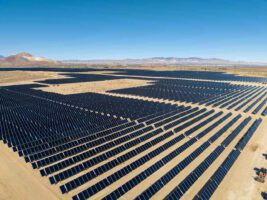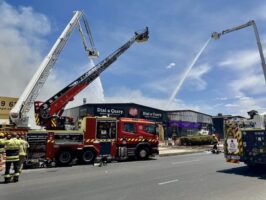The solar powered electrification of Australia’s massive gas processing plants – that is, powering the production of gas with cheaper, cleaner solar electricity, instead of, well, gas – could “dramatically reduce” the nation’s carbon footprint, a new report has found.
The report, produced by the Charles Darwin University and NERA (National Energy Resources Australia), and supported by Santos, Sun Cable and the Northern Territory government, examine the potential to decarbonise Australia’s LNG sector via electrification and large-scale renewables.
Using the Santos-operated Darwin LNG facility as a case study, the report’s authors conclude that using solar to power the LNG facilities could cut up to 50 per cent of the plant’s emissions from electricity generation.
Additional savings of nearly three times that amount could be offset with solar energy by retro-fitting the “helper motors” to partially electrify the plant’s compression turbines, which currently run on – you guessed it! – gas.
Santos’ Darwin LNG facility, which has the capacity to produce around 3.7 million tonnes of gas a year, will be used to process gas extracted from the $4.7 billion Barossa project north-west of Darwin, which was given the green light by Santos in March, the biggest investment in Australia’s oil and gas sector since 2012.
As well as being a major new source of gas, the Barossa project is also forecast to be a massive carbon bomb – it was described by the Institute for Energy Economics and Financial Analysis as an “emissions factory with a gas by-product.”
According to IEEFA, the Barossa gas field contains so much CO2 that the mere extraction of the resource will result in the release of a greater volume of greenhouse gases than the volume of usable fossil gas.
Put another way by IEEFA analyst John Robert: “Barossa gas has three times the CO2 content that the Darwin LNG plant facility can handle.”
Nevertheless, Santos’ decision to go ahead with it triggered a further $785 million investment, to extend the life of the Darwin LNG facility and pipeline tie-in projects for around 20 years.
So it’s not entirely surprising that Santos is keen to find as many ways as possible to trim the emissions from that particular facility.
But the solar electrification of Australia’s gas sector would have other beneficiaries, including Sun Cable, whose plans to build plans to build one of the world’s largest solar and storage projects in the NT will need local customers, while plans to export power to Singapore take shape.
“The Australia-Asia PowerLink will help unlock economic opportunities by providing affordable, dispatchable, renewable electricity at scale,” said Sun Cable CEO David Griffin in comments on the report’s findings on Tuesday.
“We can use our abundant levels of solar energy to remove embedded emissions in our domestic and export industries, as well as directly exporting electricity overseas, making Australia a modern renewable energy superpower.”
Meanwhile, it offers a way to at least partially offset the federal government’s unshakable plans for a gas-led recovery, while also working towards its newer and highly shaky commitment to achieve net-zero emissions for Australia by 2050.
“If this integration was implemented at all of Australia’s LNG plants, the initiative could reduce Australia’s CO2 emissions by around 5m tonnes per annum,” said Professor Suresh Thennadil, director of the Energy and Resources Institute at Charles Darwin University.
“That’s around one per cent of Australia’s total emissions up to nine per cent of the reductions required to meet Australia’s 2030 targets.”
The CEO of NERA Miranda Taylor said that, given the massive potential emissions reductions, government investment was needed – presumably to cut the cost to the gas industry of having to reduce its own emissions.
“With Net Zero goals being set globally, the LNG industry must explore all opportunities to decarbonise if it wants to stay relevant and sustainable for the decades to come,” Taylor said.
“The Australian LNG industry has historically been a relatively high-emissions industry, so seeing how the integration of renewable, solar energy — of which Australia has an abundance — can make dramatic reductions is a big step forward.”







